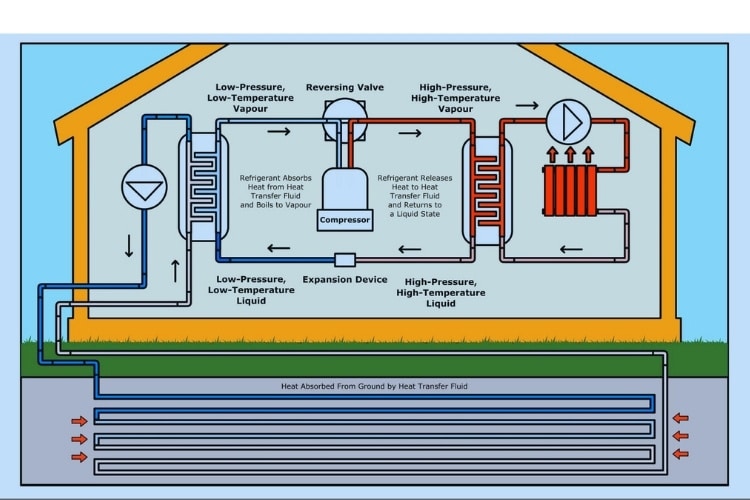A geothermal heat pump is now one of the most commonly used types of system in many homes and buildings. It is more preferred than the other systems because of the many benefits it provides. A major feature of this heating unit that gives it the edge is it’s being environment-friendly.
Geothermal energy is just one benefit we gain from the Earth. It’s free and renewable; hence, using it can really provide sufficient savings to many homeowners. In a home heating system, geothermal heat pumps are among those widely used today.
Also known as ground-source heat pumps, these systems make use of the Earth’s heat to provide the warm air needed by people when the weather gets cold.
How the System Work
Geothermal heat pumps (GHPs) get the heat from outside a home, specifically from the ground, and bring it inside to keep a family warm. The air extracted goes through some ductwork and is then circulated throughout the house using the fan.

A geothermal heating system has two types – the closed-loop and the open-loop. The closed-loop type makes use of horizontal or vertical pipes where heat is transferred to and from the ground while the open system pumps water from a well or other water source to the heat exchanger and then back to the source.
A typical loop system for the closed type is estimated to last for about 50 years. Each system is composed of three major parts – a ground loop involving pipes buried underground, the heat pump installed inside the house, and a heating and cooling distribution system, also known as ductwork. The pipes are made from durable materials such as polyethylene and copper.
Geothermal heat pumps work similarly to regular heat pumps. The only difference is that it uses the stable heat beneath the Earth’s surface to provide hot and cool air as well as hot water.
Temperature below the ground is constant throughout the year, with temperatures ranging from 45 to 75 degrees Fahrenheit, which makes underground or geothermal heat a very reliable source of energy.
In fact, studies have confirmed that around 70 percent of the energy used in a geothermal heat pump is renewable from the ground.
Unlike the conventional heating system that burns fuel, a geothermal heat pump gathers heat from the Earth and brings it to your home.
The natural heat is collected in the loop or a series of pipes and then carried to the house by water or other fluid types such as an antifreeze solution. A compressor that functions via electricity and a heat exchanger releases the geothermal energy at a high temperature as it reaches the home.
The hot air is eventually distributed to the different rooms in the house through ductwork similar to a regular forced-air system.
This type of system can also act as a cooling unit during the summer season.
The process, however, is reversed. When the weather is hot, the underground loop extracts excess heat from the house so it can be absorbed back by the Earth. This can be compared to how a refrigerator cools the food inside it, that is, by drawing heat from the inside.
A geothermal heat pump system has two main components – the condenser, which is installed outdoor, and the evaporator coil, which is installed inside the home.
Some models feature two-speed compressors and fans for added comfort. In addition, a desuperheater can even be used along with this heating system for purposes of heating water, whether at home or in buildings.
The Benefits of Geothermal Heat Pump
Heat pumps of this kind have been proven to be very efficient as they utilize a natural form of energy that is renewable.
Ground heat is very reliable in terms of heating and even in air conditioning and heating water. This is because heat underneath the Earth’s surface remains constant throughout the whole year.
During the winter season, the ground temperature is high ranging from 45 to 75 degrees Fahrenheit, while it’s the opposite during summer. A classic example is a cave that has a warmer temperature inside during the winter months and a cooler atmosphere during the summer months.
The efficiency of ground source heat pumps comes from the fact that they do not burn fuel compared to traditional home heating systems. Based on studies, about 70 percent of the energy utilized by GHPs is renewable, which means it is always in constant supply.
A geothermal heat pump uses electricity to generate heat from the ground. While conventional heaters can have an efficiency rate of 95 percent, the GHPs can achieve greater efficiency of 300 up to 400 percent even during the coldest weather.
Installation may be the only stage where homeowners need to spend a large amount. However, this should not be a major issue because of the big energy savings families can benefit from in the long run.
The U.S Environment Protection Agency (EPA) confirms that using geothermal heat pumps can lower energy bills by about 40 percent than when one uses the regular heat pumps.
Maintenance costs are not that high as well, owing to the fact that most of the outdoor components are buried underground and thereby not affected by the changing weather.
Other benefits include a longer life span, the absence of noise when in operation, and independence from the outside air.






